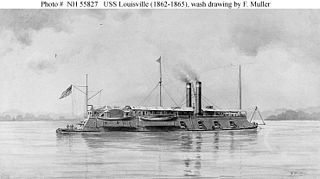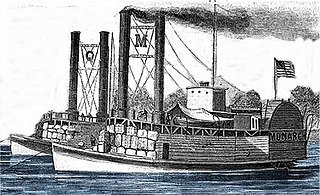
The Battle of Arkansas Post, also known as Battle of Fort Hindman, was fought from January 9 to 11, 1863, near the mouth of the Arkansas River at Arkansas Post, Arkansas, as part of the Vicksburg Campaign of the American Civil War. Confederate forces had constructed a fort known as Fort Hindman near Arkansas Post in late 1862. In December of that year, a Union force under the command of Major-General William T. Sherman left for an expedition against Vicksburg, without Major-General John A. McClernand because neither Major-Generals Henry Halleck nor Ulysses S. Grant trusted McClernand. After Sherman's force was repulsed at Chickasaw Bayou, McClernand arrived and took command from Sherman in January 1863.

USS Tyler was originally a merchant ship named A. O. Tyler, a commercial side-wheel steamboat with twin stacks and covered paddles positioned aft. Constructed in Cincinnati, Ohio in 1857, it was acquired by the United States Navy, 5 June 1861 for service in the American Civil War and converted into the gunboat USS Tyler on 5 June 1861. She was commissioned in September 1861. She was protected with thick wooden bulwarks.

The third USS Lexington was a timberclad gunboat in the United States Navy during the American Civil War.

The first USS Lafayette was a side wheel steamer, converted to an ironclad ram, in the United States Navy during the American Civil War.

USS Louisville was a City-class ironclad gunboat constructed for the U.S. Army by James B. Eads during the American Civil War.
USS Glide was a sternwheel steamer that served as a tinclad warship during the American Civil War. Built in 1862, the Union Navy purchased her for military service late that year. After being converted to a tinclad and armed with six 24-pounder Dahlgren guns, she entered service with the Mississippi River Squadron in early January 1863. Later that month, she saw action in the Battle of Arkansas Post, firing on Confederate-held Fort Hindman. Sent the next month to Cairo, Illinois, for repairs, Glide was destroyed in a fire of uncertain origin on February 7.

USS Marmora was a sternwheel steamer that served in the Union Navy from 1862 to 1865, during the American Civil War. Built in 1862 at Monongahela, Pennsylvania, as a civilian vessel, she was purchased for military service on September 17 and converted into a tinclad warship. Commissioned on October 21, the vessel served on the Yazoo River beginning the next month. She encountered Confederate naval mines on the Yazoo on December 11, and was present the next day when the ironclad USS Cairo was sunk by two mines. After further service on the Yazoo during the Battle of Chickasaw Bayou in late December, Marmora was assigned in January 1863 to a fleet that was preparing to operate against Confederate Fort Hindman, but was not present when the fort surrendered on January 11.

USS Black Hawk was a large steamer purchased by the Union Navy during the American Civil War.

USS Monarch was a United States Army sidewheel ram that saw service in the American Civil War as part of the United States Ram Fleet and the Mississippi Marine Brigade. She operated on the Mississippi River and Yazoo River during 1862 and 1863.

The City-class ironclad USS Cincinnati was a stern-wheel casemate gunboat in the United States Navy during the American Civil War. She was named for Cincinnati, Ohio, and was the first ship to bear that name in the United States Navy.

USS General Bragg was a heavy (1,043-ton) steamer captured by Union Navy forces during the American Civil War. She was outfitted as a U.S. Navy gunboat and was assigned to enforce the Union blockade of the waterways of the Confederate States of America.

USS Signal – a small 190-ton steamship – was acquired during the second year of the American Civil War by the Union Navy and outfitted as a gunboat. She also served other types of duty, such as that of dispatch vessel and convoy escort.
USS Curlew was a Union Navy stern-wheel steamer that saw service during the American Civil War. Built in 1862 in Pennsylvania as a civilian vessel, she was purchased by the Union Navy on December 17, 1862. Converted into a tinclad gunboat, she saw service from 1863 to 1865, often serving on the Mississippi River, the Ohio River, and the Tennessee River. In May 1863, she was involved in a minor action against Confederate forces on the Mississippi River off of the shore of Arkansas. July saw Curlew take part in an expedition up the Red River of the South, the Tensas River, the Black River, and the Ouachita River that captured two steamers and destroyed two more and a sawmill. On May 24, 1864, she dueled with Pratt's Texas Battery while on the Mississippi River, and on November 4 of that same year, was near the action of the Battle of Johnsonville but was unable to join the fighting. Decommissioned on June 5, 1865, she was sold in mid-August and her further career is unknown.

USS Fort Hindman was a steamer acquired by the Union Navy during the American Civil War. She was placed in service and used by the Navy to patrol navigable waterways of the Confederacy to prevent the South from trading with other countries.
The first USS Thistle was a Union Army steamer acquired by the United States Navy during the American Civil War.
USS Ivy was a steamer acquired by the Union Navy during the American Civil War.

USS Linden was a steamer acquired by the Union Navy during the American Civil War. She was used by the Navy to patrol navigable waterways of the Confederacy to prevent the South from trading with other countries.
The first USS Silver Cloud was a steamer acquired by the Union Navy during the American Civil War.

USS New Era was a steamer acquired by the Union Navy during the American Civil War. She was used by the Union Navy as a gunboat in support of the Union Navy blockade of Confederate waterways. New Era was also a name initially carried by a timbercladUSS Essex.
USS Romeo was a sternwheel steamer that saw service as a tinclad warship during the American Civil War. Completed in August 1862 for civilian trade on the Wabash River, she was instead purchased by the Union Navy for military service in October. Commissioned in December, she cleared naval mines on the Yazoo River later that month before participating in the operations against Confederate-held Fort Hindman in January 1863. After the fall of Fort Hindman, Romeo was part of an expedition up the White River. In February and March 1863, she was part of the Yazoo Pass Expedition, and she fought with Confederates at river landings later in the year to help isolate Vicksburg, Mississippi, during the Vicksburg campaign.















